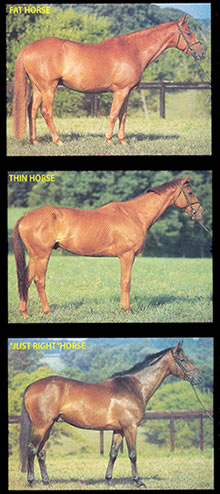You can size up whether your horse is carrying enough body weight, too little, or too much by checking out his six fat storage areas with your eyes and your fingers:

- crest of his neck
- along his withers
- behind his shoulder
- his ribs
- along his spine
- in front of his tailhead
When feeling for fat, you can differentiate it from muscle because fat has a soft, non-fibrous feeling, as if you’re pressing into an even mass. (Muscle, by contrast, feels like bundles of substantial fibers that lie in the same direction.) A thin layer of fat over bone or conditioned muscle feels like a layer of foam upholstery over a firmer surface. Where fat is thicker (as on a fat horse), you can move its mass around independently of bone or muscle underneath.
He’s too thin if…
When you stand back and look at a thin horse, the planes of his neck and shoulder appear flat and you’re aware of the bony structures beneath. His withers and pelvic bones are noticeable and you probably see the outline of all his ribs under his skin. A “poverty line” may be visible on the side of his upper hind leg, and the muscles on either side of the line look flat. His spine may protrude above the level of his back muscles; you can see the tips of individual vertebrae.
Palpate this horse’s fat storage areas and you’ll still be able to find some fat at his tailhead and in a thin covering over his ribs. His neck and withers, however, feel hard and flat. It’s difficult to feel the fat stored along his spine, where your fingers can easily explore the tips of the vertebrae. If you see a vertical line in his haunches and have any doubt whether it’s a poverty line, your fingers can let you know. The muscles beside a poverty line feel flaccid, not full and resilient as they do in the haunches of a fit horse.
He’s too fat when…
A fat horse’s muscle definition disappears as fat fills the contours between muscle masses. His ribs vanish, his neck appears thick or meaty (unless he’s a natural “pencil neck”) and the outline of his withers blurs. A pad of fat behind his shoulder muscle blends the shoulder smoothly into his rib cage. Fat fills in around his spine; he may even have a crease down his back deep enough to cradle an egg safely.
When you palpate an overweight horse, your fingers can surround the masses of fat in any of his six storage areas and wiggle them. As the bundles of fat cells pile up, this tissue takes on the texture of gelatin–and you can feel a thin layer of fat overspreading his muscles. You can, however, still detect his ribs by probing.
He’s just right when…
If you’re an amateur rider whose horse is in the amateur hunter or low jumper divisions, or through novice-level eventing or First Level dressage, the best body condition for him is the “moderately fleshy” range. His back may be level–his spine and the band of muscle (and fat) on each side form a flat surface–or may have a slight crease down the center. His neck is well filled out–the sides and topline are convex rather than flat–but it still looks muscular, not meaty. His withers are defined but appear rounded, not sharp, and you can see the muscle of his shoulder.
You can’t see your horses ribs when he’s in this condition, but you can easily feel them–and you can feel fat in the spaces between them and in the girth area behind his shoulder. You can feel some fat over his withers and behind his shoulders, and there’s a softness to the fat around his tailhead.
If your horse’s condition falls not at this happy medium but at the too-thin or too-fat end of the scale, you need to adjust his diet accordingly. Reduce a fat horse’s grain by half and keep his hay ration constant, substituting grass or timothy for any alfalfa in his diet. Give a thin horse all the hay he will eat and subsitute alfalfa for as much as half of the hay. Boost his carbohydrates with increased grain or (if he gets hot) with soaked beet pulp, oil and/or rice bran. If a just right horse tends to be high, replace corn or mixed sweet feed in his diet with oats. If he’s sluggish, substitute mixed sweet feed or corn by weight for any plain oats in his diet.
Excerpted from “Why Weight? Fat, Fitness & Your Horse,” originally published in the November 1997 issue of Practical Horseman magazine. For an explanation of how excess fat can predispose your horse to laminitis, see “Laminitis Battle Stations” in the magazine’s July 2005 issue.










